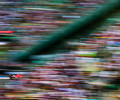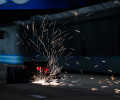2013 Japanese Grand Prix - Friday Press Conference

TEAM REPRESENTATIVES – Dave GREENWOOD (Marussia), Tom McCULLOUGH (Sauber), James KEY (Toro Rosso), Jonathan NEALE (McLaren), Pat FRY (Ferrari), Paul MONAGHAN (Red Bull Racing)
PRESS CONFERENCE
Dave if I may start with you. You’ve got a new partnership starting… I guess it’s started already. In fact, that’s the question: how’s it going?
Dave GREENWOOD: Yes, it’s going extremely well at the minute. The partnership has been running since just around the time of the August break. Obviously a lot of data going back and forth, mainly on the design side at the minute – the big challenge of integrating the engine within the chassis is what we’ve been looking at, the cooling side, those kinds of issues. So, it’s going well. It’s progressing well. Everything’s on target at the minute so we’re very happy with what’s happening.
There have been quite a few changes to the team’s technical operation. How’s that coming along?
DG: Yeah, we were disappointed to see Pat leave, he was a big part of rebuilding our team. But really, it’s Pat’s legacy that’s left behind, which is carrying on. So it’s all the same designers, the same aerodynamicists, the same people leading those team so really we’re just getting on with the job in hand and just fully focused on the 2014 car.
When you say his legacy, was that an organisational legacy – putting up structures?
DG: Absolutely. Putting up structures, discipline, good engineering practices, all the good stuff engineers should do every day and just making sure everyone’s doing it and they’re all on the same sheet.
Tom, obviously a fantastic result last weekend with fourth and in fact you’ve also scored points in the last three races. What’s changed, what’s different?
Tom McCULLOUGH: To be honest we started the year uncompetitively, in position. The pace from the midfield wasn’t too far but we just weren’t scoring the points. We kept coming home from every race weekend, analysing the data, both in low-fuel qualifying and long-run race pace and thinking to ourselves ‘we’re not that far away, but we’re just the wrong side’. We decided to push on the development of the car. We introduced our biggest update package by far for Budapest – totally changed the concept of the rear of the car aerodynamically. Did a lot of work really from the front wing right the way through to the rear wing on the car – it’s a very different car to what was actually launched. And we’ve just addressed the main problems that were limiting us from a car balance and a lap time point of view. The change of tyres happened around the same time too, so lowering the front ride height on a Formula One car tend to help you as well. But, fundamentally, for us the biggest difference really started in Budapest. We didn’t score points but we saw how the car was working aerodynamically and we’ve just built on that from there really.
And now you’re locked in a battle in the Constructors’ Championship with your former colleague and now neighbour up there from Toro Rosso. So how’s the development? Is that still continuing?
TMcC: We brought forward our final update package from India to the previous race in Korea, so there are now no more new parts on our car between now and the end of the year. We’ve had to push the development of this year’s car a little bit more than we wanted to, just because we were on the back foot at the start of the year and we had a few problems to address. So, we’ve been developing both cars in parallel, this year’s and next year’s car. At the moment, level on points. We were a bit lucky with some circumstances last weekend but I think as Jean-Eric said yesterday, it’s sort of game on from here really. We’re starting with the same points, pretty similar car performance from track to track, there’s not a lot in it. So, there’s going to a good little fight between now and the end of the year.
Yes. James, as JEV said yesterday, it’s now a five-race championship for you. What are your thoughts on it?
James KEY: I think what Tom says reflects it well. It is going to be close, to the point where certain tracks and certain conditions suit the different cars slightly differently. It’s going to be tight. It’s exciting to be in a battle like that. But not where you want to be with five races to go with a massive regulation change next year. It’s another balancing act. I think it’s going to be interesting and it is a five-race championship. Starting from this point the rest is all information we can use in these next five races.
What’s Toro Rosso’s reaction going to be? Have you stopped you development or have you got more coming?
JK: On the aero side we have. We brought our last bits in Singapore. We’ve got a few small items to come. Mechanically, there’s sort of an ongoing development process a little bit with trying to adapt to the tyre change still because that had a negative effect on us we think. We kind of know why but there are still a few things to do. There’s a little bit of that going on but fundamentally the car is what it is now, there’s nothing major coming along at all at this stage. And clearly with next year’s car very much the focus of the team there’s not much resource to do that.
So, it’s really almost going to be track specific from now on?
JK: I think yeah it’s potentially going to be down to small detail.
Jonathan, obviously Honda is looming but quite a long way away still. What is the situation? Did you go and seen them, have you been to see them here. How closely are you now working with them?
Jonathan NEALE: We are seeing them here during the course of this weekend. It’s an exciting proposition for us to be back with them. We’ve been working very closely for 10 months or so since we dropped the flag, which is not long in Formula One terms but they’re a powerful organisation and moving heaven and earth at the moment and that’s an exciting prospect. But although that’s on the horizon we’re very much focused on the work we’re doing with Mercedes at the moment because, as the others have alluded to, the step change in regulations for next year means we’ve got to do the job twice in two years, so we’ve got our work cut out.
And in terms of drivers that still seems to be fairly fluid as well?
JN: Yeah, as Martin and Jenson said during the Korean Grand Prix weekend we’ve confirmed what we’re doing on that side but the other side if still open for discussion. But we’re under no immediate pressure. I know there’s a lot of media expectation, I understand that but there’s nothing in the regulations, no structural reason why we’d want to make that decision without careful consideration. So that’s what we’re doing.
Still very much watch this space then?
JN: Yeah, very much so.
Q: Pat, first of all, a big challenge from Mercedes in the Constructors’ Championship. How much is that actually hurting 2014?
Pat FRY: In terms of development, we’ve got some parts coming through for the next couple of races but that’s already in the pipeline, that’s not really affecting the 2014. Obviously it’s quite a close-fought battle with them. They’ve got outstanding qualifying pace and their race pace is sometimes good, sometimes bad. Again, I expect that’ll be another one of those five-race championships you were just talking about.
Q: Was Korea a bit of a blip? You’d actually finished second in the previous three races.
PF: Yeah. I think where we qualified in Korea is similar to what we’ve been able to do before really and there’s no point hiding behind our poor qualifying pace. The race, in reality, we were caught in traffic and couldn’t get past so credit to the people who were there holding us up a little.
Q: So is it looking better for this weekend?
PF: I hope so, yes. So far.
Q: Paul, obviously huge progress since the summer break. Things have completely changed, you’ve dominated every race since then. What changed?
Paul MONAGHAN: A few small items. It’s been remarkably subtle, the pieces that have gone onto the car but the collective effect has been enormously positive and it’s spread to many areas and that’s opened up a few little other paths of development which we’ve managed to exploit and yes, we’ve been very lucky – and enjoyed it.
Q: Obviously you had a huge amount of damage on Mark’s car last weekend. Can you give us some indication of what’s been required since then?
PM: It’s very easy to summarise. Pretty much everything behind the oil radiator was ruined. So it’s a whole new car from the cockpit backwards for him. New chassis, or a replacement chassis, and everything is new there behind it.
Q: Was that all built up here, did you have all the spares with you?
PM: The majority of them actually were with us, yes. A few parts have made their way out here but we’ve survived remarkably well.
QUESTIONS FROM THE FLOOR
Q: (Dan Knutson – Auto Action and National Speedsport News) Paul, as Mark’s time in F1 winds down, give us an idea of how it has been to work with him over the years?
PM: I’ve known him since 2002, I think, when he was Renault test driver. He was committed then, he’s still very committed now, always professional, always gives good feedback. He complements Sebastian extremely well. They both contribute to car development and he’s continuing to do so. It’s been at outstanding career, hasn’t it? Very impressive.
Q: (Dieter Rencken – RacingLines) Gentlemen, there has been a lot of talk about Formula One possibly adopting customer cars. Now this concept could put some of you out of a job for obvious reasons and turn others into super salesmen. Where do you stand on this particular issue from an engineering or technical perspective?
JN: It’s a contentious subject which of course is why you asked the question. I think that on the one hand Formula One still has to be the pinnacle of motor sport and there is a certain sense of technical endeavour in that, providing that we moderate that from a financial point of view. Customer cars is a game-changer, certainly for the independent teams; it fundamentally changes that business model and I think before Formula One goes about that, I think it needs to look at the economic sustainability of the various business models that exist. Whether you’re premium brand, whether you’re independent or whether you’re an entrant into it, then in any market sense, you make sure that you’ve got something that works holistically. Technically, for us, it’s not as big a deal. I think commercially it’s a much bigger issue but I don’t think the technical guys will say it’s too much of a challenge. But it would fundamentally change for me what Formula One is and I think Formula One is about the pinnacle of motor sport and that technical element is very important to it, and I believe that the independent teams would say the same thing.
PF: Well, I suppose in reality it’s more a question for the team principals than engineers really. From an engineering point of view, I’m sure it would be relatively easy to put something in place but it’s more, as Jonathan was saying, about which way do we want to see the sport going.
PM: From a purely technical point of view, Formula One is the Constructors’ championship – there’s a Drivers’ championship and a Constructors’ championship and therefore, solely from that point of view, then we ought to compete against one another. However, we currently sell parts to other teams as we’re permitted to do so, so an amount of part-sharing, to ease the burden on other teams that wish to buy certain components from us, then I think it’s absolutely the right thing to do. If that expands a little bit and all the teams agree, then it’s probably a helpful thing for the sport.
DG: Personally, I think we’ve got the balance about right at the minute. What you can and can’t buy from someone else is probably about the right place and still gives us the ability to be engineers and go off and design things and not just take wholesale someone else’s parts. I think in effect it allows us to buy the really complicated bits – gearboxes, hydraulics etc – and then lets us go off and concentrate on the other parts.
TMcC: Yeah, I really can’t add too much more. For us, as performance-base engineers running a spec car or a customer car wouldn’t be as much fun. Like Dave was just saying, some of the more complicated expensive parts with a lot of tooling research and development, I think the balance is pretty good at the moment. Then we, as trackside engineers, can push hard on the performance side of the car and that’s a fantastic opportunity for people like myself working with great wind tunnels, great bunch of people, just developing performance.
Q: James, Toro Rosso have just invested quite a lot in their technical assets recently.
JK: Absolutely. It’s often maybe misunderstood but Toro Rosso’s very much a team in its own right. We work well with Red Bull where we can, for example the same engine for next year and so on but yes, we have invested. I think, certainly, there’s a commercial side which is not within the remit of technical directors to comment on but technically it’s not difficult but there’s a big emotional thing there because we are all competitive people who want to go and beat the other guy and a big part of that is making your own car so it’s quite a big topic on a number of levels, I think.
Q: Anything further to add, Jonathan, having heard from the technical directors?
JN: Only that I would echo that the balance of being able to trade parts to a team that maybe has a smaller budget or is a new entrant I think is a really important part of attracting investors in, because as in any business you want to invest what resource you have in what makes a difference and it takes time to put the capital footprint down and to put the competence in place. If you’re trying to do all that from day one, your chance of survival and then running properly into the series... I think the risk is induced and you make it less attractive as an investment proposition.
Q: (Sam Collins – RaceCar Engineering) Question for the guys in the back row: one of the things you guys are indulging in is a battle for Constructors’ positions but at the same time you’re trying to develop quite a complicated car for next year within the resource restriction agreement. How are you managing the cost of developing the car against the cost of trying to get those points to get the Constructors’ positions and the money it pays out, particularly in the case of Marussia as well?
DG: To a certain extent we have thrown most of our weight behind 2014 and quite a long time ago but that’s not to say we’ve not had small developments which have come recently and they’ve been extremely cost-effective developments which has helped as well and the financial burden of 2014 is big as well. Basically, by judging small mechanical upgrades that can maybe help optimise the aerodynamics of the car – by that, obviously, I mean suspension to allow you to run in the place and the track to get the best downforce from the map you’ve got – so we’ve worked a lot on those small parts which can give you gains for not very much money and also not very much lead time which is good. So we’re still doing a certain amount of filtering back ideas from the track back to design: is it easy to design, is it easy to make, can we do it for the next race? Yes, OK, let’s go for it, but the emphasis is very much on 2014.
TMcC: Yeah, for us it’s a little bit different due to the position we’ve found ourselves in at the start of the year, as I sort of mentioned earlier. Nowadays, as well as cfd, the wind tunnel, aerodynamics on the track, these are all things which we are monitoring all the time and trying to improve. The regulations next year are obviously quite different from our power train point of view, the influence of the exhaust on the downforce is obviously quite different but for us, fundamentally there are some flow mechanisms and understanding of this year’s car which we really had to get on top of and understand before we just abandoned it an early stage and got straight into the 2014 car, so we’ve had a bit of a different approach. Now, from a resource point of view we’ve had to be careful not to throw too much at this year’s car but it’s always that balance as an engineer: fundamentally understanding this year’s car was pivotal for us to design a good car next year so we’ve played that balance.
JK: I think similar thoughts really. There are certain things you can learn this year which will help you next year but a lot of the major bits are not carry-over at all so it really is a balancing act of trying to efficiently do what you can, let’s say in the latter half of this season primarily, for this year and make sure you’re not losing focus on next year. It’s always tricky because when these regulations come along so does an opportunity to take a step forward but there will be a risk of damaging your previous year if you do that, so it’s very much a balancing act. I think with the lack of the carry-over of a lot of the stuff that you do, you have to try and – as Tom says – tune a little bit of what you need to understand to make it relevant for next year as well.
Q: (Dan Knutson – Auto Action and National Speedsport News) James, now that you’ve had a chance to look at the cars, what caused your drivers to retire in Korea?
JK: It was actually a brake duct issue which I’ve never seen before. It was very frustrating, we had the same problem on the same lap for both drivers and it obviously meant, unfortunately, that we had to retire them which was a real shame. I think points for Daniel were relatively clear and secure and in fact we were just about to tell him to push to try and catch the guy ahead at the end so it was very frustrating for all of us. It was actually a structural failure on brake ducts which shouldn’t cause any damage but they led to us having to retire the cars because of temperature problems.
Q: Did it have any overheating impact on the engines, is there any reduction in life in the engines?
JK: No, we think the engines are OK. It was a general effect around the car when you have something which moves and causes a flowfield issue. We think we’re OK there. It didn’t actually cause any more damage than the parts themselves that broke in the end but unfortunately it was enough to have to retire.
Q: (Dieter Rencken – RacingLines) Jonathan, you said earlier on that you’ve got to do the job twice, i.e. in 2014 and then again in 2015. A lot of teams have two separate design operations, one working on the next year and the other on the one thereafter. Is that the approach that you’ve adopted and does that fit into McLaren’s matrix system?
JN: No. There’s just so much to be done in the near term that it’s all hand on deck. We’re 12 weeks away from the end of the year, 16 weeks away from putting the car out for a test or something like that; I think a Formula One car is 13,500 parts with the engine as one part number. There’s a lot of work to do with almost no carry-over. Everybody will be focused on trying to get the learning out of this and I think there’s so much still to be discovered through those early two or three months of running these cars, both from a reliability and energy optimisation, aerodynamics, the new flow structures around the car. I’m not quite sure what you would start your next one on so we’ve got to learn and digest all that first.
Q: (Sam Collins – RaceCar Engineering) How do the five engineers here feel about going into the 2014 competition season with no running on the wet tyres with the new powertrain?
PF: I’m honestly not quite sure how to answer the question really. The wet tyre performance at the moment is a little bit of a challenge and how would you ever test a tyre and prove it I don’t know. It’s one of those impossible questions to answer but I’m sure we’re all going to be uneasy over that step into the unknown. I’m sure you can say that at the first test, when we run out on slick tyres, for instance, exactly how are the tyres going to behave with the new powertrain. The torque delivery of the power units are quite dramatically different and I suppose the stress that’s put on the tyres in qualifying compared to the race will also be dramatically different from this year. I think there’s a learning curve on both the slick and the wet tyres to be honest.
PM: It’s going to be interesting, isn’t it? We’ll see what happens. Like all of these things, once you’re faced with a wet track and the car’s got to go, then you will deal with the circumstances as they arise to you. It’s a challenge, we’ll all face it and we’ll all treat it in different ways and I’m sure we’ll all come out the other side thinking it wasn’t too bad.
DG: Yeah, I echo the two guys’ comments, honestly. You’ll deal with it as it happens and those who’ve made the best job of it will get something out of it. I guess that’s one way to look at it.
TMcC: Not really much more to add really. With the wet tyre you’ve got torque delivery to deal with and you will work with those parameters to get the most out of your package.
JK: Same.
Ends

 Facebook
Facebook Twitter
Twitter





